
Introduction
Brief overview of transformer structure
Transformer structure plays a crucial role in the efficient transfer of electrical energy through electromagnetic induction. Comprising various components, transformers regulate voltage levels to facilitate seamless power transmission between circuits.
Bobbin in Transformer Structure
Definition and role of bobbin
The bobbin is a crucial component in transformer construction, serving as a support structure for the windings. It provides insulation between the windings and the core, ensuring proper alignment and spacing of the coils while preventing electrical contact and short circuits.
Types and materials of bobbins used in transformers
Bobbins come in various types and are typically made from materials such as plastic, phenolic, or ceramic. They are available in different shapes and sizes to accommodate the specific requirements of transformer designs, ensuring optimal winding arrangement and electrical insulation.
Silicon Steel in Transformer Structure
Importance of silicon steel in transformer cores
Silicon steel, also known as electrical steel, is a crucial material used in transformer cores due to its magnetic properties. It helps minimize core losses, such as eddy current and hysteresis losses, by providing high magnetic permeability and low electrical conductivity.
Properties and grades of silicon steel used in transformers
Silicon steel comes in various grades and thicknesses, each optimized for specific applications and operating conditions. Higher silicon content and thinner laminations contribute to reduced core losses and improved transformer efficiency.
Core in Transformer Structure
Role and significance of the core
The core forms the central part of the transformer structure and serves as a pathway for magnetic flux. It consists of stacked laminations of silicon steel, which help confine and channel the magnetic field generated by the windings, thereby facilitating efficient energy transfer between the primary and secondary circuits.
Materials and construction of transformer cores
Transformer cores are typically constructed from high-quality silicon steel laminations, which are coated and stacked to minimize core losses and optimize magnetic flux distribution. The core design and construction are critical factors in determining transformer efficiency, performance, and reliability.
Insulation Materials in Transformer Structure
Types and functions of insulation materials
Insulation materials are used to electrically insulate the various components of the transformer, including the windings, core, and terminals. They prevent electrical breakdown and leakage currents while ensuring the safe and reliable operation of the transformer.
Importance of insulation in transformer design
Insulation plays a vital role in transformer design by providing dielectric strength, thermal stability, and mechanical support to the winding and core assemblies. Proper insulation selection and implementation are essential for maintaining transformer integrity and performance under various operating conditions.
Conclusion
Recap of key components in transformer structure
Transformers consist of several key components, including the bobbin, silicon steel core, and insulation materials, each playing a crucial role in ensuring efficient energy transfer and electrical isolation within the device.
Importance of each component in transformer performance and efficiency
Each component of the transformer structure contributes to its overall performance and efficiency. Proper selection, design, and construction of these components are essential for optimizing transformer operation, minimizing losses, and ensuring reliable performance in electrical power distribution systems.